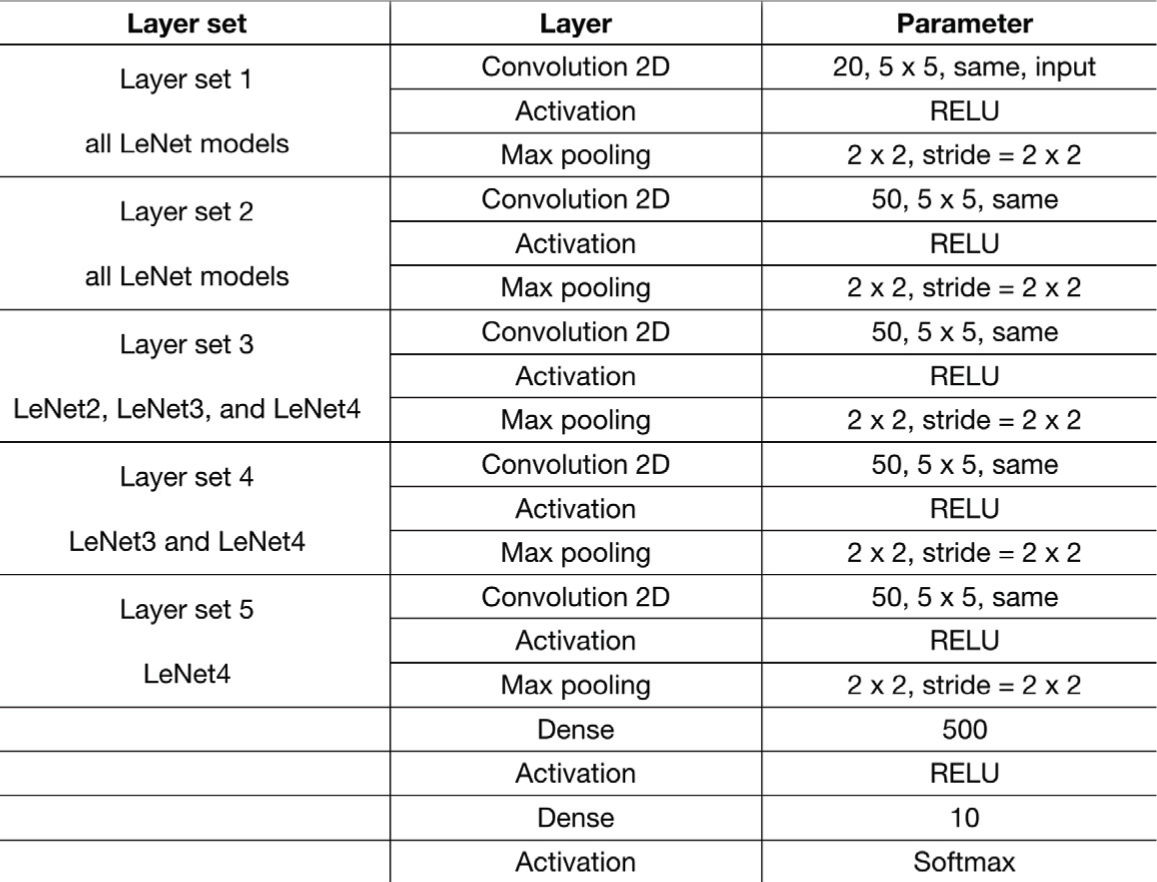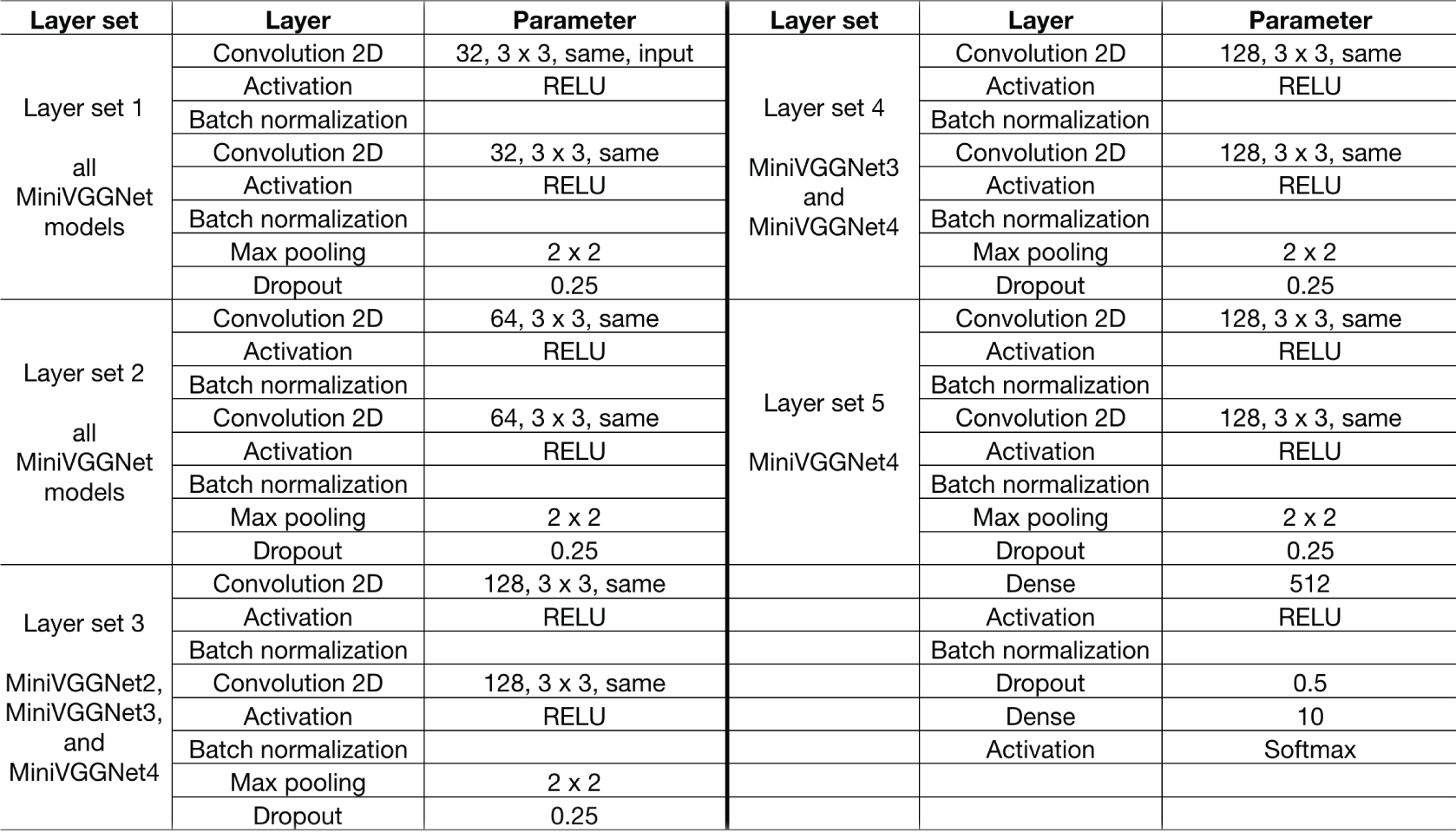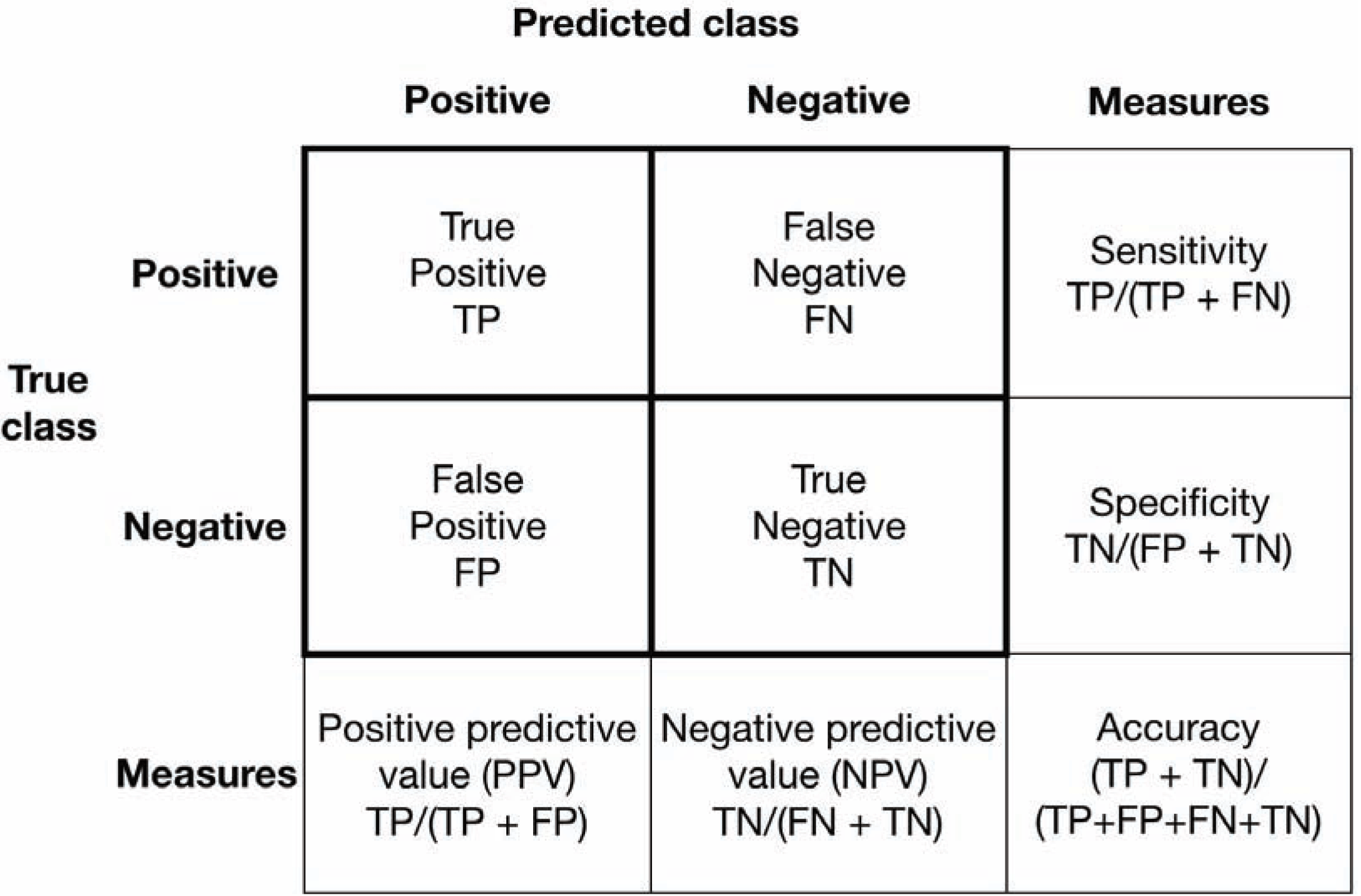1. INTRODUCTION
Wood species identification is essential for many fields of science, engineering, and industry, but also wooden cultural heritage (Kim and Choi, 2016; Eom and Park, 2018; Lee et al., 2018; Park et al., 2018) in Korea. There are various ways of wood identification by utilizing morphological and spectroscopic features of woods. Yang et al. (2017), Park et al. (2017), and Yang (2019) proposed wood identification by spectroscopic and chemical characteristics of Korean softwood species. However, still, the most common methods for the wood species identification utilize visual and morphological features of the wood.
There has been a demand for automatic wood species identification by computer-aided machine vision identification systems based on visual and textural features (Koch, 2015). Most of the machine vision identification systems were designed to use in a laboratory environment (Tou et al., 2007; Khalid et al., 2008; Hermanson et al., 2011). Hermanson et al. (2013) from USDA Forest Products Laboratory developed XyloTron system that is a field-deployable wood identification system. In more recent years, researchers adapted deep learning techniques for feature extraction and classification of images of wood at various scale. Hafemann et al. (2014) developed the convolutional neural network (CNN) models for macroscopic (41 classes) and microscopic (112 species) images of wood. Tang et al. (2017) proposed an automatic wood species identification of macroscopic images from 60 species of tropical timbers. Kwon et al. (2017) developed an automated wood species identification system for five Korean softwood species. These studies used macroscopic images from the cross-sectional plane of wood and taken by either a digital camera or smartphone camera. Ravindran et al. (2018) utilized transfer learning of CNN models to identify 10 neotropical species in the family Meliaceae.
Although the automatic wood identification software successfully classified the five species (cedar, cypress, Korean pine, Korean red pine, and larch) of Korean softwood (Kwon et al., 2017), there are practical limitations of the system stemming from the training images, which are from the transverse plane of the wood species. The transverse surface is very rough and often characteristic pattern of growth rings was hidden by the rough surface. Sometimes the end surface is covered by paint preventing crack development along rays in the transverse surface. At mills, they process lumbers running longitudinal direction, and thus it is hard to catch the transverse surface of the lumber without stopping the process.
These practical limitations of wood species identification at the fields lead us to develop a new model suitable for the longitudinal surfaces from the three principal surfaces of wood. As we investigate patterns on the surfaces of longitudinal plane, the patterns are not as clearly distinguishable as those from the transverse surface. Also, there are considerable variations of patterns due to a mixture of earlywood, latewood, and rays, which are not in the exact orthogonal planes. The vast varieties of patterns cause drops of classification performance of the automatic wood species identification system for the longitudinal surfaces of lumbers.
From our experience of development of the CNN models for the transverse surface, we figured out that different CNN models show better accuracy for different species. In the previous study, we chose LeNet3 model considering overall accuracy and balance between accuracies for each species, not biased to select a model showing the highest accuracy for a species but not for others. It was a close call to choose between LeNet3 and MiniVGGNet3. LeNet3 showed the highest accuracy for cedar, but MiniVGGNet3 showed the best for cypress and larch. However, the accuracy variation of LeNet3 was less than that of MiniVGGNet3.
We expect a decrease of classification performance of LeNet3 and MiniVGGNet3 for the images from the longitudinal surfaces of lumbers due to complex but less distinctive features for identification. A remedy for the decrease of classification performance is the utilization of a group of predictors called an ensemble (Rosebrock, 2017). Ensemble methods generally refer to training a large number of models and then combining their output predictions via voting or averaging to yield an increase in classification accuracy. By utilizing an ensemble model, it is possible to increase the classification performance by a combination of the strengths of different CNN models.
In this study, we developed an ensemble model for automatic wood species identification system utilizing smartphone images from transverse and longitudinal surfaces of lumbers of five Korean softwood species (cedar, cypress, Korean pine, Korean red pine, and larch). We proposed a method for the selection of an optimal ensemble model. Precision, recall, and F1 score were calculated and constructed a confusion matrix to describe the classification performance of the selected ensemble model.
2. MATERIALS and METHODS
Five Korean softwood species [cedar (Cryptomeria japonica), cypress (Chamaecyparis obtusa), Korean pine (Pinus koraiensis), Korean red pine (Pinus densiflora), and larch (Larix kaempferi)] were under investigation by an automatic wood species identification utilizing ensembles of different CNN models. We purchased fifty lumbers of each species of 50 × 100 × 1200 mm3 (thickness × width × length) from several mills participating in the National Forestry Cooperative Federation in Korea. The lumbers in each species were from different regions of Korea.
Images of the transverse surface were from wooden blocks of 40 × 50 × 100 mm3 (R × T × L) prepared from each lumber (50 wood samples per species). For images of the longitudinal surface, we prepared lumber of 40 × 50 × 600 mm3.
We used smartphones (iPhone 7, Samsung Galaxy S3, Samsung Galaxy Tab4 Advanced) to obtain macroscopic pictures of the sawn surfaces of cross sections of the specimen. During the image acquisition process, the smartphones placed on a simple frame as stable support. The camera in an iPhone 7 model has a f/1.8 lens and phase detection autofocus function and produces an image of 12 megapixels. The camera produces a color picture of 3024 × 4032 pixels. Galaxy S3 model has a f/2.6 lens and autofocus function and produces a color image of 3264 × 1836 pixels. Galaxy Tab4 Advanced has a camera with 5 megapixel CMOS and autofocus function. It produces a color images of 1280 × 720 pixels.
We prepared 33,815 images of 512 × 512 pixels by utilizing a sliding window method; 25,361 images of all (75 %) for training and the other 8,454 images (25 %) for validation. Table 1 lists the number of images for each species corresponding to the wood species and surfaces as well as class name and index. We used the class indices in Fig. 2, 3, and 4 as tick labels in the x axis.
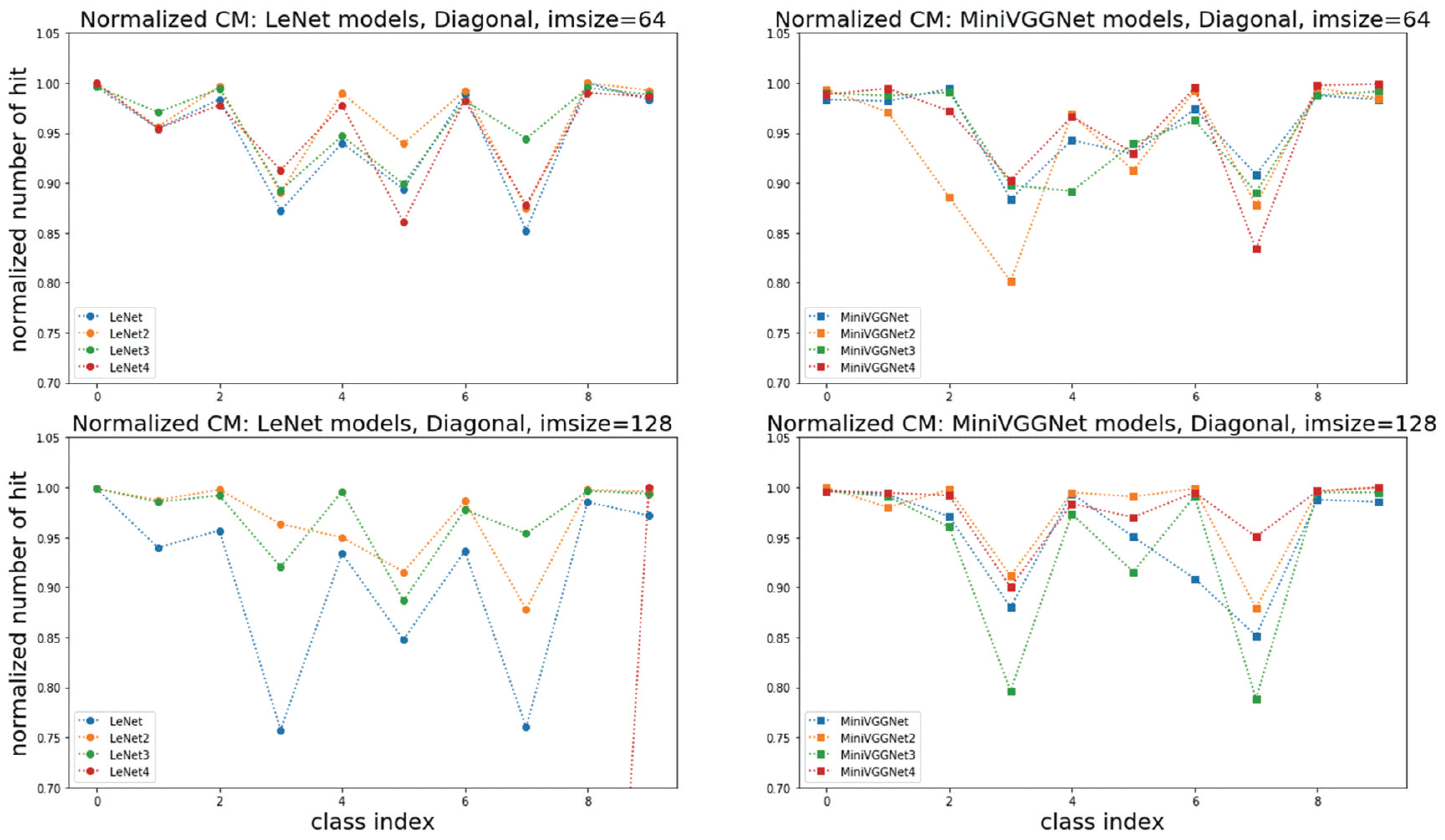
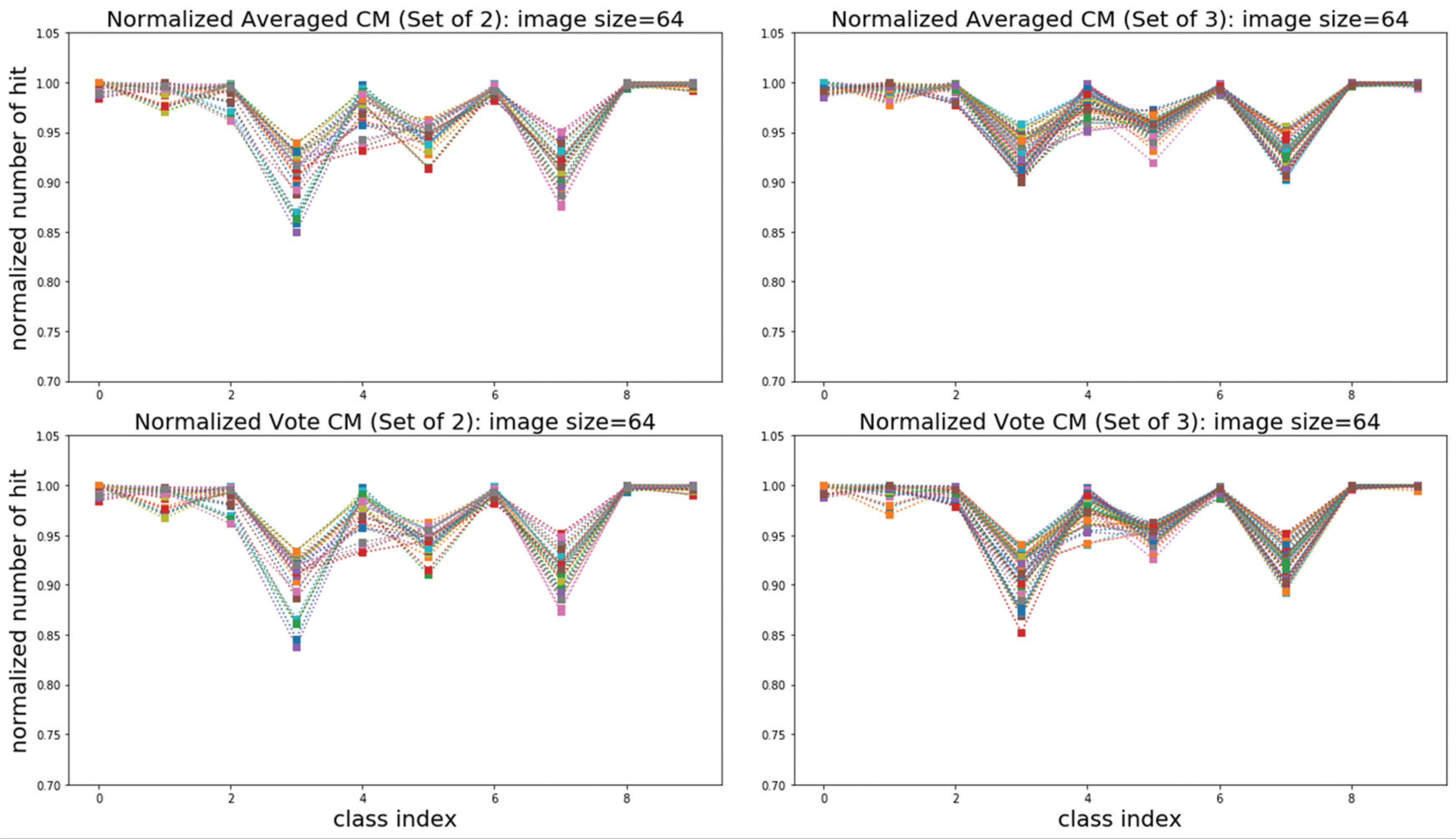
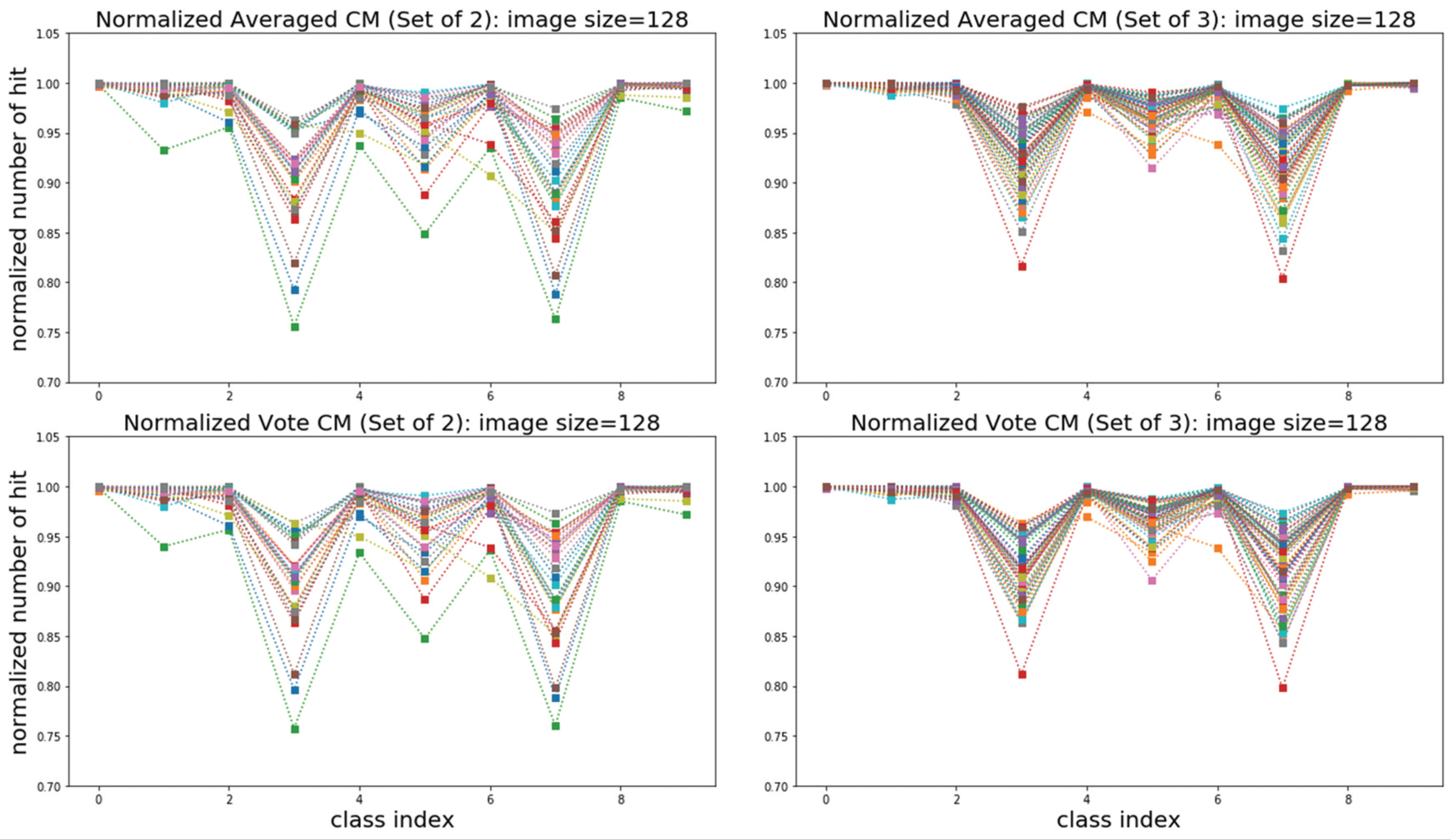
An ensemble of CNN models requires several operational CNN models such as LeNet (Lecun et al., 1998) and VGGNet (Simonyan and Zisserman, 2014). We already developed and demonstrated the classification performance of LeNet3 and MiniVGGNet3 models in the previous study (Kwon, et al., 2017). During the development, we investigated the performance of variants of LeNet and MiniVGGNet architectures (Table 2 and 3) such as LeNet, LeNet2, LeNet4, MiniVGGNet, MiniVGGNet2, and MiniVGGNet4. Each model showed different performance on the classification of transverse images from five Korean softwood species.
We utilized these eight CNN models to construct ensemble models for classification of two types of lumber surfaces: (1) transverse and (2) longitudinal surfaces. Each CNN model is trained for the images from the two types of surfaces of the five Korean softwood species. Then we examined combinations of two or three CNN models among the eight CNN models: (1) Sets of two CNN models: 28 combinations (e.g. LeNet-LeNet2, LeNet2-LeNet3, LeNet3-MiniVGGNet2, and so on) and (2) Sets of three CNN models: 56 combinations (e.g. LeNet-LeNet3-MiniVGGNet2, LeNet3- MiniVGGNet-MiniVGGNet3, and so on). The reason we investigated the performance of various combinations of the CNN models is that ensemble methods are computationally expensive. If fewer CNN models result in sufficient classification performance, it is not necessary to use an excessive number of models.
We applied two methods for prediction results from the ensemble models: (1) averaging and (2) max voting. From the performance measurement, we determined a better method for automatic wood species classification from the transverse and longitudinal surfaces of lumbers.
For training the ensemble models, we utilized a workstation with XEON CPU (14 cores) with 64 GB of memory as well as GPU with 24 GB (NVIDIA Quadro M6000). The operating system was Ubuntu 16.04 LTS with CUDA 8.0, Python 3.5, Tensorflow 1.2 and Keras 2.0.
Image patches covering at least several growth rings from the transverse surface are necessary to utilize macroscopic features of different wood species. We determined the patch size according to the given condition for macroscopic features of all wood species. In the case of the smartphone camera without a zoom factor, the field of view (FOV) in 512 × 512 pixels was turned out to be a proper size. For other surfaces of lumber, we kept the same FOV to maintain the same feature ratio as in the transverse surface.
The original images were reduced to 64 × 64 and 128 × 128 pixels as input images for training purpose. Pixel values of the input images were normalized by 255. Image augmentation was performed as with the following parameters: rotation range = 30, shift range in width and height = 0.1, shear range = 0.2, zoom range = 0.2, and horizontal flip. We utilized the Stochastic Gradient Descent (SGD) algorithm as an optimizer with learning rate = 0.01 and Nesterov momentum = 0.9. The number of epochs was 250.
We evaluated the classification performance of each CNN model as well as various combinations of the CNN models by constructing a confusion matrix. A confusion matrix (or an error matrix) is a table containing summaries of the classification performance of a classifier with respect to some test data. It visually presents the performance as a two-dimensional matrix with the true and the predicted class (Fig. 1). We prepared a confusion matrix to visually display other types of error arisen from different combinations of true and predicted conditions.
From the confusion matrix, we can calculate precision, recall, and F1 score that describe how a model performs. Precision is a positive predictive value, but recall is a true positive rate, sensitivity, or probability of detection. The F1 score is a good indicator of representing the performance of models according to a balance between precision and recall of a model, and we can calculate the following equation. We used F1 scores for comparison purpose for the classification performance of the models and ensemble sets used in this study. The F1 score can be calculated as
We need to investigate the classification performance of eight types of ensemble models: (1) size of input image: 64 × 64 × 3 or 128 × 128 × 3, (2) ensemble method: averaging or max voting, and (3) number of CNN models used in an ensemble model: 28 combinations from set of two or 56 combinations from set of three. Due to a large number of ensemble models under investigation, we devised a method to choose an optimal ensemble model with the best performance. A selection of an optimal ensemble model is as followed:
For each ensemble model, make a confusion matrix with normalized values
Extract diagonal values from the confusion matrix
Calculate the mean and standard deviation of the extracted values
Calculate an SNR-like value as a measure for classification performance: SNR = Signal-to- Noise Ratio
Select an ensemble model resulting in the highest SNR-like value
Tabulate the SNR-like values corresponding to the cases to be tested
Determine an optimal ensemble model with an optimal method and the size of an input image
The SNR-like value can be calculated by an equation: s = mean/standard deviation. The SNR-like measure describes the degree of misclassification for each class, which treats some misclassified cases as noise - the higher the SNR-like value, the better the classification performance of the ensemble model.
3. RESULTS and DISCUSSION
All individual models (LeNet1~4 and MiniVGGNet1~4) showed lower classification performance for the ten classes (Table 1) from the transverse and longitudinal surfaces of the five Korean softwood species than that for the five classes from the transverse. Especially, classification performance for the longitudinal surfaces was significantly lower than for the transverse surfaces. Average and standard deviation of the recall values were LeNet models with 64 × 64 × 3 images: (0.956, 0.046), 128 × 128 × 3 images: (0.736, 0.401), MiniVGGNet models with 64 × 64 × 3 images: (0.951, 0.050), 128 × 128 × 3 images: (0.961, 0.055), (average, standard deviation) respectively. MiniVGGNet models trained with 128 × 128 × 3 images showed better performance than LeNet models trained with 64 × 64 × 3 images (Fig. 2).
LeNet models did not show significant differences for 64 × 64 × 3 images but showed significant variations in performance trained with 128 × 128 × 3 images (Fig. 2, left-top and left-bottom graphs). On the other hand, MiniVGGNet models showed large variations of performance trained with 128 × 128 × 3 images. However, the best classification performance was from a MiniVGGNet model trained with 128 × 128 × 3 images (Fig. 2, right bottom graph).
From the normalized diagonal elements of the confusion matrices for the CNN models, we expected that combinations of LeNet2, LeNet3, MiniVGGNet2, and MiniVGGNet4 models would result in the excellent classification performance as ensemble models trained with input images of 128 × 128 × 3. However, for the input images of 64 × 64 × 3, it was difficult to predict an optimal combination of the individual CNN models would result in the best performance.
Between the ensemble methods, there was no significant difference, but the averaging method showed marginally better performance than the voting method did (Fig. 3 and 4). Thus, the averaging method as an optimal ensemble method.
In general, the effect of input image size on the performance of the ensemble models was significant. For the ensemble models with 3 CNN models, ensemble models with input images of 64 × 64 × 3 showed less variable than those with 128 × 128 × 3 images did in performance of the ensemble models (Fig. 3 and 4). However, the highest performance was found from the results with 128 × 128 × 3 images. Since input images of 64 × 64 × 3 did not show significant differences in classification performance corresponding to the ensemble methods and the number of CNN models in an ensemble model, we determined the size of input images as 128 × 128 × 3.
The ensemble models showed a similar pattern to the individual LeNet and MiniVGGNet models, but the increase of overall performance (Fig. 2, 3 and 4). Regardless of the sizes of input images and the ensemble methods (averaging and voting), ensemble models with 3 CNN models showed better performance than those with 2 CNN models (Fig. 3 and 4).
We determined the SNR-like measure for input images of 64 × 64 × 3 (Table 4) and 128 × 128 × 3 (Table 5). The ensemble models with 3 CNN models by the averaging method showed the best performance. The ensemble models with 3 CNN models by the averaging method showed the best performance. Among the ensemble models with 2 and 3 CNN models, the best classification performance resulted by the combinations of [LeNet3-MiniVGGNet3] and [LeNet3- LeNet4-MiniVGGNet3] models trained with 64 × 64 × 3 images, but those by [LeNet2-MiniVGGNet4] and [LeNet2-LeNet3-MiniVGGNet4] models trained with 128 × 128 × 3 images.
| Ensemble model | Averaged | Voting |
|---|---|---|
| LeNet3 and MiniVGGNet3 (averaged, voting) |
36.55 | 33.87 |
| LeNet3, LeNet4, and MiniVGGNet3 (averaged) LeNet2, LeNet3, and MiniVGGNet3 (voting) |
51.95 | 38.63 |
| Ensemble model | Averaged | Voting |
|---|---|---|
| LeNet2 and MiniVGGNet4 (averaged, voting) |
59.74 | 55.89 |
| LeNet2, LeNet3, and MiniVGGNet4 (averaged, voting) |
69.79 | 61.29 |
Difference between [LeNet3-MiniVGGNet3] and [LeNet3-LeNet4-MiniVGGNet3] models was LeNet4 model, which is an additional CNN model to the ensemble of 2 CNN models. Similarly, difference between [LeNet2-MiniVGGNet4] and [LeNet2-LeNet3-MiniVGGNet4] was LeNet3 model. We thought that LeNet4 and LeNet3 models increased the classification performance of the ensemble models with 2 CNN models.
Based on the new measure (SNR-like value), we determined the LeNet2-LeNet3-MiniVGGNet4 model as the best ensemble model, but we need to investigate other aspects of the classification performance of other ensemble models by confusion matrix. Comparison of the F1 scores from the selected ensemble models according to the SNR-like measures showed no significant difference among the models (Fig. 5). However, the confusion matrices revealed the distribution of false negative (FP) cases, and it was possible to determine the best ensemble model from their FP distributions. In Fig. 5, the ensemble models with two CNN models (a and b) showed more misclassification cases than those with three CNN models (c and d). Between the two ensemble models with three CNN models (c and d), the ensemble model (d) (trained with input images of 128 × 128 × 3) showed less misclassifications than (c) (trained with input images of 64 × 64 × 3). Therefore, we confirmed that the best ensemble model among the ensemble models under investigation in this study was the [LeNet2-LeNet3-MiniVGGNet4] model.
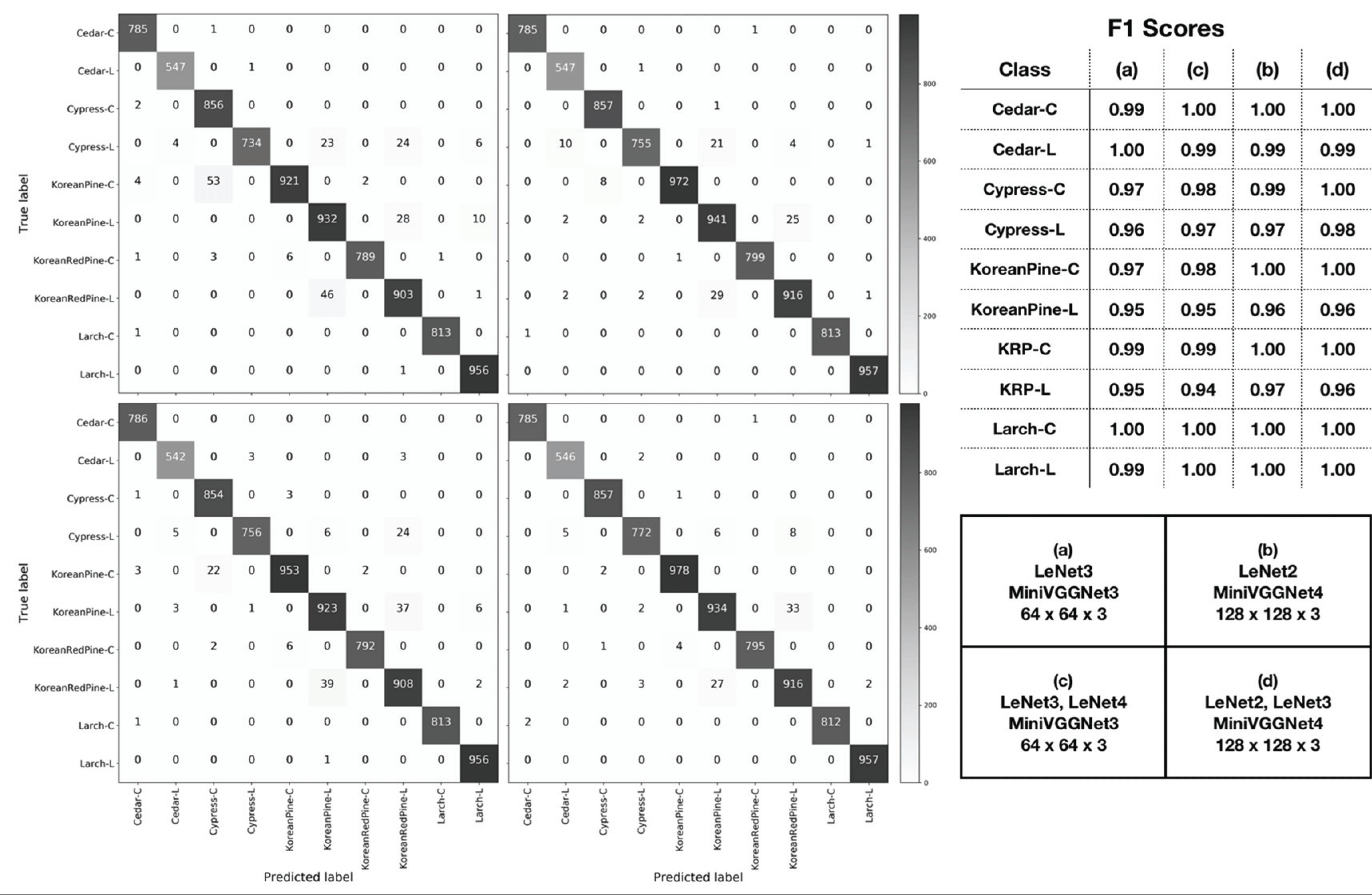
The measures of classification performance of the [LeNet2-LeNet3-MiniVGGNet4] model was listed in Table 6. Overall performance was excellent, but classification performance for the longitudinal surface of Korean pine and Korean red pine was lower than that for other surface images. However, the performance was significantly improved by the ensemble model compared to individual CNN models such as LeNet3 and MiniVGGNet3 (Table 7) for the longitudinal surfaces of Korean pine and Korean red pine.
4. CONCLUSION
In this study, we investigated the use of ensembles from LeNet and MiniVGGNet models to automatically classify the transverse and longitudinal surfaces of five Korean softwoods (cedar, cypress, Korean pine, Korean red pine, and larch). Images from cameras in mobile devices such smartphone and tablet were used to provide macroscopic images to the ensemble models.
The experimental results showed that the best model was the ensemble model by the averaging method consists of [LeNet2-LeNet3-MiniVGGNet4] models trained with input images of 128 × 128 × 3. The ensemble model showed F1 score of > 0.96. Classification performance for the longitudinal surface of Korean pine and Korean red pine was significantly improved by the ensemble model compared to individual CNN models such as LeNet3.









